
Safe use of rotary tools: Expert tips
Key Takeaways
- Always wear appropriate safety gear such as goggles, gloves, and dust masks.
- Understand the tool's operation before starting any project.
- Use proper attachments specifically designed for the task at hand.
- Keep your workspace clean and free from hazards.
- Regularly inspect the tool and its wiring for any signs of wear or damage.
Rotary tools are incredibly versatile and can be used for a variety of tasks, from cutting and grinding to engraving and polishing. However, with great power comes great responsibility. It is essential to utilize them safely and effectively. This guide will explain expert tips to enhance your experience while ensuring utmost safety.
Understanding rotary tools
Rotary tools, such as Dremels, are handheld devices that spin a attachment at high speed, making them suitable for intricate work. Below is a table summarizing the parts of a typical rotary tool and their purposes:
| Part | Purpose |
|---|---|
| Motor | Powers the rotating spindle. |
| Collet | Holds the attachments firmly in place. |
| Speed Control | Adjusts the rotation speed for different applications. |
| Power Switch | Toggles the tool on or off. |
Safety practices for rotary tool usage
1. Wear appropriate safety gear
Before starting your project, ensure you are equipped with the necessary safety gear:
- Protective goggles: To shield your eyes from flying debris.
- Gloves: To protect hands and provide better grip.
- Dust mask: To avoid inhaling dust created by the tool.
2. Familiarize yourself with your tool
Before getting started, take time to understand the rotary tool’s instructions. Here are some essential aspects:
- Read the user manual thoroughly.
- Learn how to change attachments and adjust the speed.
- Know the recommended uses for each attachment.
3. Select the right attachment
Different tasks require different attachments. Here’s a quick guide to commonly used rotary tool attachments:
| Attachment Type | Best For |
|---|---|
| Cutting wheels | Cutting and slicing through materials. |
| Sanding drums | Sanding wood or smoothing surfaces. |
| Diamond bits | Etching and engraving hard materials. |
| Polishing pads | Polishing and finishing surfaces. |
Best practices for using rotary tools
To ensure the effective use of rotary tools, consider the following best practices:
1. Keep your workspace organized
A cluttered workspace can lead to accidents. Maintain an orderly area by:
- Clearing away unnecessary materials.
- Ensuring adequate lighting.
- Keeping cords out of walkways to avoid tripping hazards.
2. Regular tool inspections
Regular maintenance of your rotary tool can prevent accidents. Always check for:
- Worn or damaged attachments.
- Frayed cords or loose connections.
- Accumulated dust and debris in the housing.
3. Follow proper techniques
Proper techniques will not only improve your work quality but also your safety:
- Let the tool do the work; do not apply excessive force.
- Keep a firm grip while using the tool.
- Always cut away from your body.
Common mistakes to avoid
To prevent accidents and mistakes, be cautious of the following wrong practices:
- Neglecting to secure loose clothing and long hair.
- Using the wrong attachment for a task.
- Ignoring unusual sounds from the tool, which might indicate a problem.
Pros
- Highly versatile and adaptable for multiple tasks.
- Offers precision and control in projects.
- Portable and suitable for both indoor and outdoor use.
Cons
- Can be dangerous if not used properly.
- Overheating if used for extended periods without breaks.
- Requires practice to master complex tasks.
Conclusion
Rotary tools are a fantastic addition to your toolbox, offering endless possibilities for tasks. However, prioritizing safety is paramount. By following expert tips and best practices shared in this guide, you can enhance your skills while minimizing risks. If you want to learn more about related tools, check out our detailed buying guides or explore the top-rated multi-tools for your next project.
